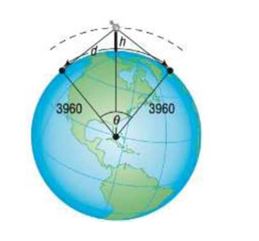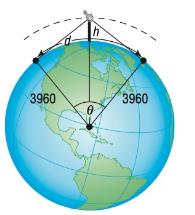
Concept explainers
Surveillance Satellites A surveillance satellite circles Earth at a height of miles above the surface. Suppose that is the distance, in miles, on the surface of Earth that can be observed from the satellite. See the illustration on the following page.
(a) Find an equation that relates the central angle to the height A.
(b) Find an equation that relates the observable distance and .
(c) Find an equation that relates and .
(d) If is to be 2500 miles, how high must the satellite orbit above Earth?
(e) If the satellite orbits at a height of 300 miles, what distance on the surface can be observed?

a. Find an equation that relates the central angle to the height h.
Answer to Problem 78AYU
a.
Explanation of Solution
Given:
A surveillance satellite circles Earth at a height of miles above the surface. Suppose that is the distance, in miles, on the surface of Earth that can be observed from the satellite. See the illustration on the following page.

Formula used:
Calculation:
a.
b. Find an equation that relates the observable distance and .
Answer to Problem 78AYU
b.
Explanation of Solution
Given:
A surveillance satellite circles Earth at a height of miles above the surface. Suppose that is the distance, in miles, on the surface of Earth that can be observed from the satellite. See the illustration on the following page.

Formula used:
Calculation:
b.
c. Find an equation that relates and .
Answer to Problem 78AYU
c.
Explanation of Solution
Given:
A surveillance satellite circles Earth at a height of miles above the surface. Suppose that is the distance, in miles, on the surface of Earth that can be observed from the satellite. See the illustration on the following page.

Formula used:
Calculation:
c. From a. and b, .
d. If is to be 2500 miles, how high must the satellite orbit above Earth?
Answer to Problem 78AYU
d. miles.
Explanation of Solution
Given:
A surveillance satellite circles Earth at a height of miles above the surface. Suppose that is the distance, in miles, on the surface of Earth that can be observed from the satellite. See the illustration on the following page.

Formula used:
Calculation:
d. miles.
miles.
e. If the satellite orbits at a height of 300 miles, what distance on the surface can be observed?
Answer to Problem 78AYU
e. miles.
Explanation of Solution
Given:
A surveillance satellite circles Earth at a height of miles above the surface. Suppose that is the distance, in miles, on the surface of Earth that can be observed from the satellite. See the illustration on the following page.

Formula used:
Calculation:
e.
radians.
miles.
Chapter 8 Solutions
Precalculus Enhanced with Graphing Utilities
Additional Math Textbook Solutions
University Calculus: Early Transcendentals (4th Edition)
College Algebra with Modeling & Visualization (5th Edition)
Thinking Mathematically (6th Edition)
Introductory Statistics
College Algebra (7th Edition)
Basic Business Statistics, Student Value Edition
- A factorization A = PDP 1 is not unique. For A= 7 2 -4 1 1 1 5 0 2 1 one factorization is P = D= and P-1 30 = Use this information with D₁ = to find a matrix P₁ such that - -1 -2 0 3 1 - - 1 05 A-P,D,P P1 (Type an integer or simplified fraction for each matrix element.)arrow_forwardMatrix A is factored in the form PDP 1. Use the Diagonalization Theorem to find the eigenvalues of A and a basis for each eigenspace. 30 -1 - 1 0 -1 400 0 0 1 A= 3 4 3 0 1 3 040 3 1 3 0 0 4 1 0 0 003 -1 0 -1 Select the correct choice below and fill in the answer boxes to complete your choice. (Use a comma to separate vectors as needed.) A basis for the corresponding eigenspace is { A. There is one distinct eigenvalue, λ = B. In ascending order, the two distinct eigenvalues are λ₁ ... = and 2 = Bases for the corresponding eigenspaces are { and ( ), respectively. C. In ascending order, the three distinct eigenvalues are λ₁ = = 12/2 = and 3 = Bases for the corresponding eigenspaces are {}, }, and { respectively.arrow_forwardN Page 0.6. 0.4. 0.2- -0.2- -0.4- -6.6 -5 W 10arrow_forward
- Diagonalize the following matrix, if possible. 8 0 6 - 8 Select the correct choice below and, if necessary, fill in the answer box to complete your choice. 8 0 OA. For P= D= 0 3 6 0 B. For P = D= 0 -6 8 0 C. For P = D= 0 - 8 D. The matrix cannot be diagonalized.arrow_forwardCalculus lll May I please have the solutions for the following exercises? Thank youarrow_forwardCalculus lll May I please have the solution for the following question? Thank youarrow_forward
- Find three horizontal tangents between [0,10]arrow_forward4 In the integral dxf1dy (7)², make the change of variables x = ½(r− s), y = ½(r + s), and evaluate the integral. Hint: Find the limits on r and s by sketching the area of integration in the (x, y) plane along with the r and s axes, and then show that the same area can be covered by s from 0 to r and r from 0 to 1.arrow_forward7. What are all values of 0, for 0≤0<2л, where 2 sin² 0=-sin? - 5π 6 π (A) 0, л, and 6 7π (B) 0,л, 11π , and 6 6 π 3π π (C) 5π 2 2 3 , and π 3π 2π (D) 2' 2'3 , and 3 4元 3 1 די } I -2m 3 1 -3 บ 1 # 1 I 3# 3m 8. The graph of g is shown above. Which of the following is an expression for g(x)? (A) 1+ tan(x) (B) 1-tan (x) (C) 1-tan (2x) (D) 1-tan + X - 9. The function j is given by j(x)=2(sin x)(cos x)-cos x. Solve j(x) = 0 for values of x in the interval Quiz A: Topic 3.10 Trigonometric Equations and Inequalities Created by Bryan Passwaterarrow_forward
 Calculus: Early TranscendentalsCalculusISBN:9781285741550Author:James StewartPublisher:Cengage Learning
Calculus: Early TranscendentalsCalculusISBN:9781285741550Author:James StewartPublisher:Cengage Learning Thomas' Calculus (14th Edition)CalculusISBN:9780134438986Author:Joel R. Hass, Christopher E. Heil, Maurice D. WeirPublisher:PEARSON
Thomas' Calculus (14th Edition)CalculusISBN:9780134438986Author:Joel R. Hass, Christopher E. Heil, Maurice D. WeirPublisher:PEARSON Calculus: Early Transcendentals (3rd Edition)CalculusISBN:9780134763644Author:William L. Briggs, Lyle Cochran, Bernard Gillett, Eric SchulzPublisher:PEARSON
Calculus: Early Transcendentals (3rd Edition)CalculusISBN:9780134763644Author:William L. Briggs, Lyle Cochran, Bernard Gillett, Eric SchulzPublisher:PEARSON Calculus: Early TranscendentalsCalculusISBN:9781319050740Author:Jon Rogawski, Colin Adams, Robert FranzosaPublisher:W. H. Freeman
Calculus: Early TranscendentalsCalculusISBN:9781319050740Author:Jon Rogawski, Colin Adams, Robert FranzosaPublisher:W. H. Freeman
 Calculus: Early Transcendental FunctionsCalculusISBN:9781337552516Author:Ron Larson, Bruce H. EdwardsPublisher:Cengage Learning
Calculus: Early Transcendental FunctionsCalculusISBN:9781337552516Author:Ron Larson, Bruce H. EdwardsPublisher:Cengage Learning





